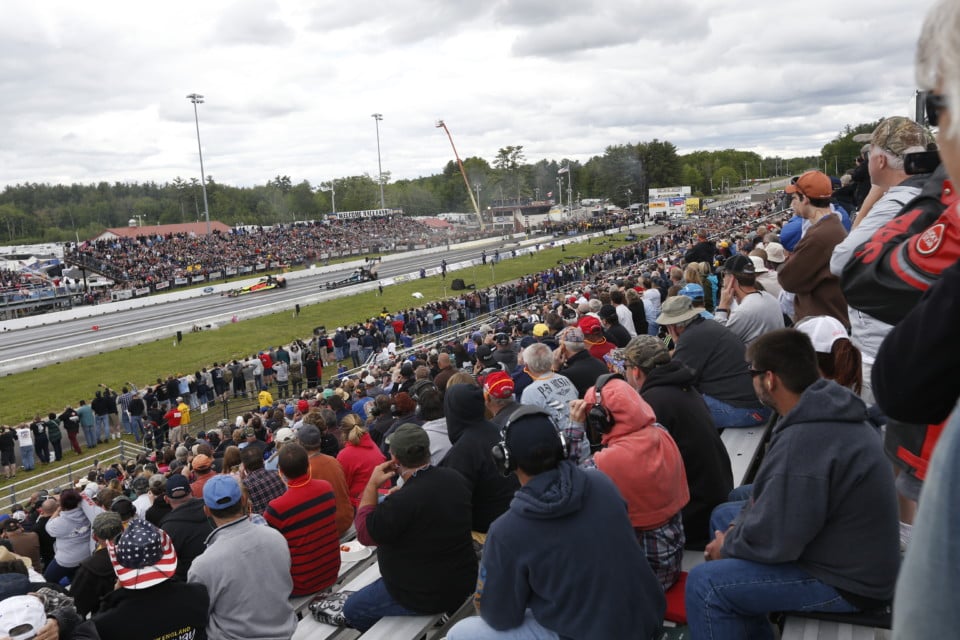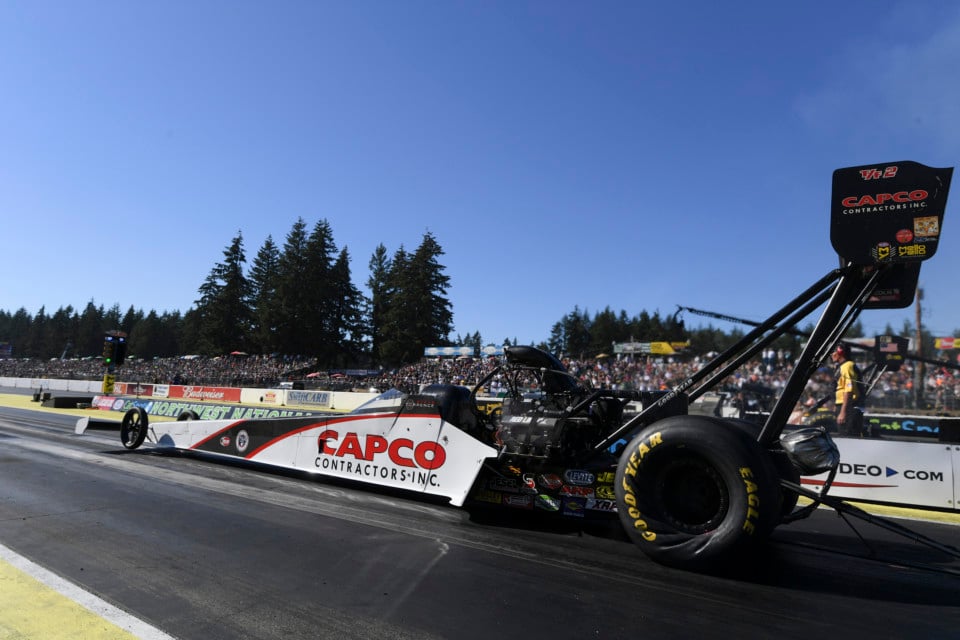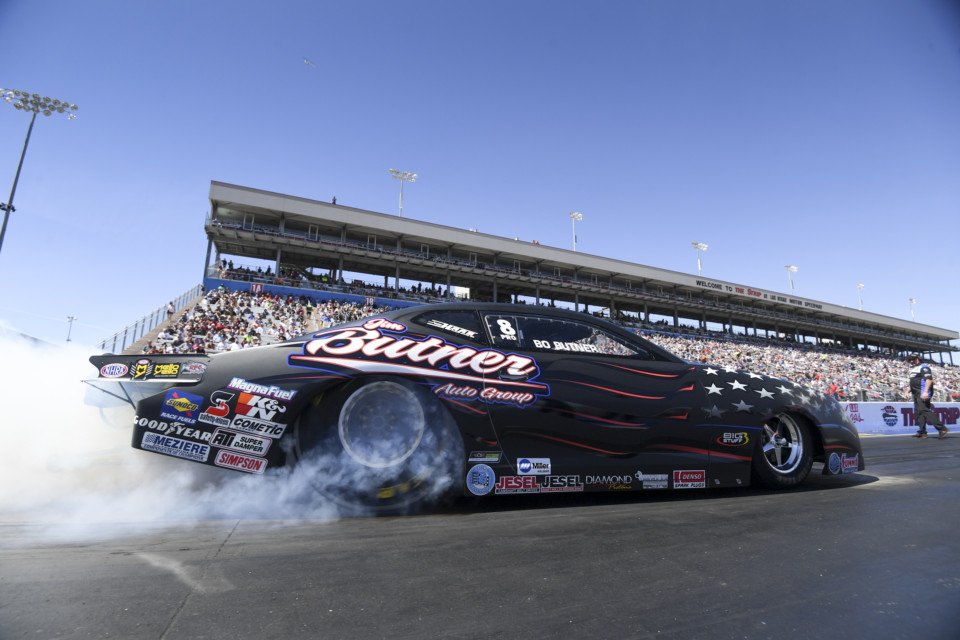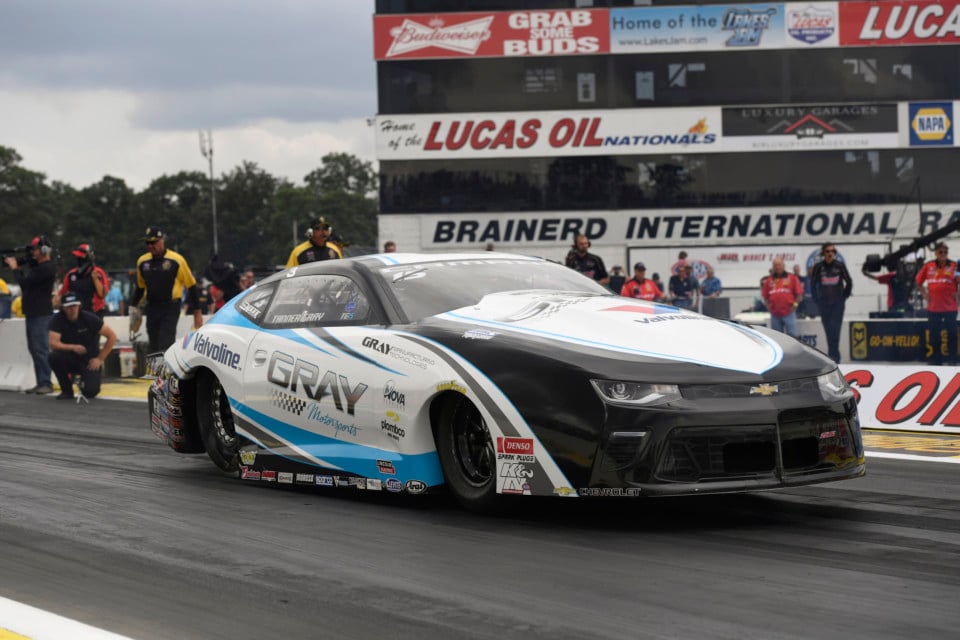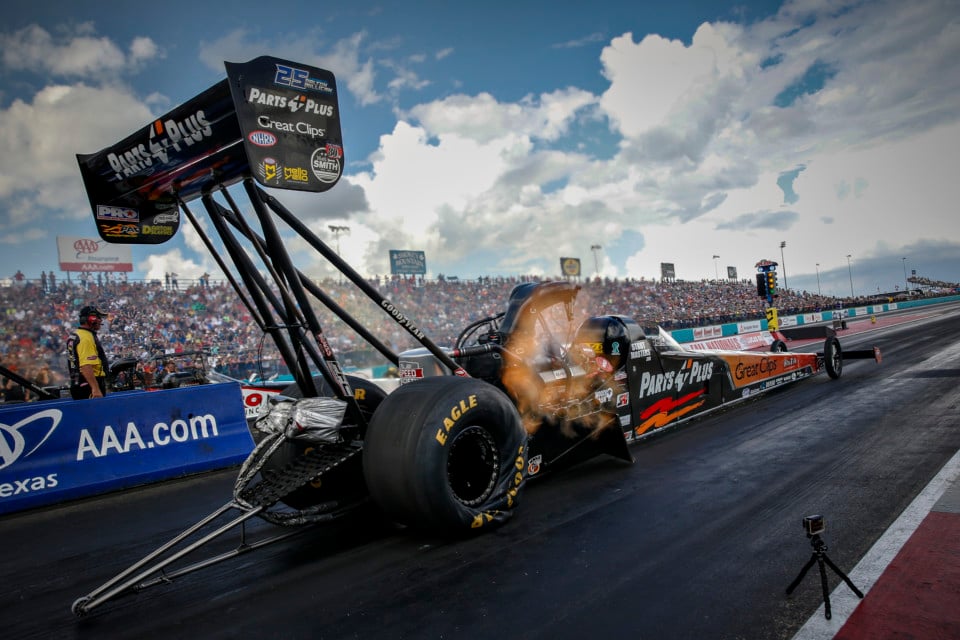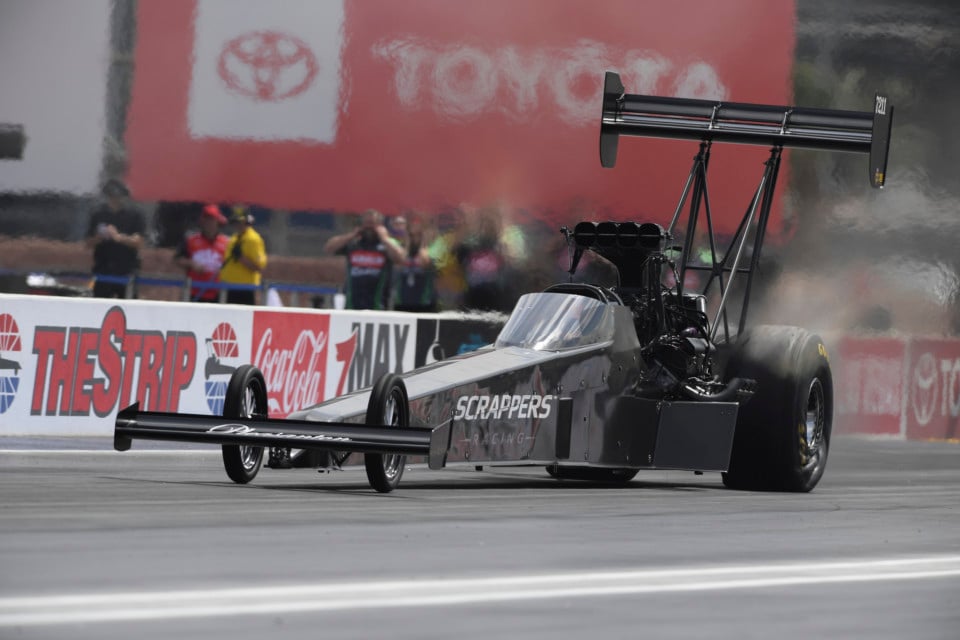It’s not readily apparent on the surface. It hasn’t yet had a demonstrable effect on the product we see as we flip on our televisions on a Sunday afternoon and watch full fields (more often than not) of Top Fuel dragsters and Funny Cars squaring off in battle. The sky is indeed not falling — not today, maybe not next year. But eventually, without action, things won’t be as they are today. And the sooner the sanctioning body and its race teams get proactive and make some difficult decisions that are long past due, the better the likelihood of a prosperous tomorrow for professional drag racing.
At the heart of the matter is a confluence of out-of-control operating costs and a barren desert of sponsorship opportunities that could prove disastrous for the NHRA in time should it not address the issue head-on. While the nitro fields remain — for the most part — full, behind the scenes, many teams remain on shakier ground than this rather risk-averse author would be comfortable with. Nearly half of the fuel teams on any given weekend are either self-funded or funded out of the goodness of someone’s heart — a far cry from the days when McDonald’s, Budweiser, Miller Lite, Taco Bell, GM, Castrol, and other major brands adorned the world’s fastest racecars for one specific purpose: return on investment.
Such valuable brands — or any major sponsorship really — have become increasingly difficult to come by, and the NHRA is not alone in that. NASCAR, IndyCar, even Formula 1 have not been immune to corporate America’s shift to other marketing venues or tightening of the purse-strings, so it’s not a drag racing problem, it’s an economic one.
And drag racing can either sit idly by and ride the ship into the iceberg, or it can act.
In 2019, the Pro Stock schedule was, controversially enough, trimmed from 24 races to 18. But the effect was precisely opposite of how many would have predicted: race teams actually reconsidered and returned to the series in greater numbers than they left it, showing their approval of the decision and the reduction in operating costs that would result. Chris McGaha noted in a recent DRAGZINE feature that it costs his team $10,000 per race to contest the NHRA Mello Yello Series, and much of that rests in travel expenses.
“The car is the least expensive thing. It’s the people it takes to run 24 races. It’s moving your truck and trailer around for 24 races. That’s what costs the money. Relatively speaking, the car is cheap. It really is. That’s like third or fourth down the list of line items of expense,” he commented, adding, “I wasn’t going to run but 16-18 races myself anyway, even if they’d had 24.”
Not that the nitro team owners hadn’t already considered the merit of a reduced race schedule before, but what it’s seen in Pro Stock this season has most certainly verified any and all notions they had.
So, how does the NHRA accomplish this, specifically?
Let’s start here.
Sixteen points races per season maximum. It effectively needs to trim eight races — eight races with supportive fanbases and tracks that depend on the revenue they generate annually. But you don’t have to cut the lifeline to those races and tracks entirely.
The NHRA has the widest tentacles in the sport, with access to a smorgasbord of eliminators and machines to put on the finest show in drag racing: Pro Modified, Mountain Motor Pro Stock, the Factory Stock Showdown, Nitro Harley, and Top Alcohol Dragster and Funny Car, nevermind its professional eliminators that star in any show. It has also utilized Nostalgia Funny Cars, Fuel Altereds, jet cars, wheelstanders, and Gassers in supporting roles in the past.
By putting its dusty promoters’ cap back on, the NHRA can utilize this supporting cast, along with a booked-in program of top-flight fuel cars — and even small-time nitro teams that have largely disappeared from the landscape — to create a wild-west show at select tracks not too dissimilar from the famed World Series of Drag Racing in Cordova, Illinois. In doing so, its professional race teams will reap the benefits of a reduced schedule and a limited number of paid appearances elsewhere. Figure 18-19 outings a season in total, give or take.
Eight races is a reduction of the schedule by 33-percent.
Obviously a reduction in costs of 33-percent isn’t exact math, because the operating costs behind the scenes in staff, machinery, and parts may not be reduced by a correlating percentage, but assume it could: a $4 million sponsorship proposal to XYZ Corporation becomes $2.7 million. Could that help XYZ envision a return on investment that it doesn’t see at $4 million…enough so to sign on the dotted line? I like to save money, how about you?
So let’s get down to specifics: how does the NHRA accomplish this?
1) Reduce Pomona, Las Vegas, and Charlotte to a lone national event
I get it — Pomona is the NHRA’s home-field, full of history and located right in the heart of the birthplace of fuel racing, but it doesn’t consistently draw a large crowd and the events are limited by local regulations. The Winternationals has been contested at Pomona since 1961 — it was just the second national event ever — and would, for the sake of tradition, stand to be the event that remains. The Finals, likewise, isn’t exactly steeped in heritage at Pomona — yes, it’s been held there for the last 35 years, but it previously called Tulsa, Oklahoma, Dallas, Texas, Amarillo, Texas, and Ontario, California home, so a change of venue for the finale isn’t that out-there of an idea.
Charlotte, likewise, has not drawn spectator counts in vast quantities — the multi-colored seats often obscuring the actual attendance. Las Vegas, meanwhile, is traditionally well-attended, but in order to pair the schedule down, difficult cuts have to be made.
2) Chicago, Seattle, Richmond, Brainerd, and Epping converted to non-points exhibitions
The Route 66 Raceway is one of the finest modern super-tracks on the NHRA tour, but since its opening in 1998 it has featured far more empty blue seats than occupied seats in its stadium-like structure. Thanks to its location just a short three-hour drive from Indianapolis, this is a prime location for a nitro exhibition among the sport’s perennial teams. Contest the JEGS Allstars and the full slate of sportsman categories and make an epic show out of it.
At an estimated 4,250-feet, the Virginia Motorsports Park is among the longest tracks on the NHRA circuit. As such, it is among the likely suitors for 1/4-mile fuel racing or fuel exhibitions. Track owner Tommy Franklin knows how to put on a show, and situated in the heart of doorslammer country, a 32-car Pro Modified field and a 1/4-mile exhibition, along with the sportsman categories and perhaps Nitro Harley and/or the Factory Stock Showdown would pack the joint.
The New England Nationals has been a part of the NHRA Mello Yello Series tour since 2013, and while a wonderful addition to the calendar with a passionate fanbase, the facility is not up to par with others on the tour. Given its geographic location, it’s also not well-supported by the racers, evident by what was collectively the shortest field of nitro cars of the season thus far.
The event could likely continue on in an exhibition capacity, perhaps with Funny Cars and Pro Stock, combined with other region-specific eliminators.
Like Epping, Seattle is a geographical outlier for many teams. And its facilities are also a step or two below par. Shortening the Western Swing to two races would decrease travel expenses and time spent on the road for the professional teams. Like Chicago, a booked-in fuel show can be combined with an NHRA Heritage Series event, contesting Nostalgia Funny Car and Top Fuel, along with other old-school categories, to assemble a show worthy of purchasing a ticket.
Brainerd falls into the same category as some of the previously-mentioned venues, in that its facility lags behind the standard set by other tracks. But with a 37-year heritage on the Mello Yello Series tour and inarguably the most passionate collection of fans in drag racing, the place deserves to continue being a part of the NHRA fold in an exhibition and sportsman racing capacity.
With that, eight events are carved from the schedule, without entirely eliminating nitro racing from those that didn’t make the cut. Depending on revenues generated at the gate and the resulting booking fees, nitro teams could, in theory, operate separate of their sponsorship budget at those limited exhibition appearances. And, as noted earlier, such a system could promote the return of independent nitro teams for booked match race opportunities.
There’s plenty of additional creativity you could invoke here. Why not a booked-in, non-points 16-car (eight Top Fuel versus eight Funny Car) all-star race again at Bristol? Or even converting Norwalk back to a non-points exhibition, ala its Night Under Fire? And with both Reading and Topeka carrying some question marks, the overall schematic of the schedule and which tracks have exhibitions could be adjusted accordingly in the future.
3) A Texas-Sized Finale
With just one event at Las Vegas and a newly-minted four-wide surface at The Strip, it’s a no-brainer that track owner Bruton Smith will want to keep his four-abreast contest. And because teams will not appreciate the idea of deciding the championships under such a format, why not close the season in either Dallas or Houston, in a state with some NHRA World Finals lineage? I’m sure the fourth and ninth most populous cities in America, respectively, have some fine establishments to conduct the NHRA awards ceremony.
How about a championship schedule that looks a little something like this, with some adjustments for geographic purposes:
- Pomona
- Houston
- Gainesville
- Atlanta
- Charlotte
- Bristol
- Norwalk
- Topeka
- Denver
- Sonoma
- Indianapolis
- Reading — Countdown opener —
- St. Louis
- Phoenix
- Las Vegas
- Dallas
Is some tradition lost in a sweeping set of changes such as this? Of course there is. No one under the age of 40 can even remember a time when there wasn’t a three-race Western Swing, that Brainerd wasn’t on the schedule, and that the traveling roadshow didn’t culminate in Pomona. But consider the alternative.
The NHRA needs a product, and it needs a healthy one. Its cars and its personalities are that product, and when wonderful representatives of the sport like Leah Pritchett and Ashley Sanford, who fully get the idea of branding and promotion in the modern world, can’t find adequate sponsorship, something is amiss. When a world-class team owner like Alan Johnson can’t procure a backer, something is amiss. And while curbing costs isn’t necessarily going to have Corporate American suddenly lining up with fresh ink pens ready to sign agreements, anything that can be done to improve the chances of acquiring backers is a step in the right direction. And, if absolutely nothing else, it simply opens the door for well-to-do, self-funded individuals like Billy and Steve Torrence and Mike Salinas to enter the professional drag racing ranks at a lesser cost.
We got here — 24 races a season — seemingly of a burning desire from the top to keep pace with NASCAR. Now, stock car racing has its own set of troubles that a reduced schedule could potentially benefit. To put what the NHRA and its teams need to do in the most basic of analogies: if it can’t afford filet mignon, it would be wise to focus on a juicy pork chop.
How Might Costs Be Further Reduced?
With just 16 or fewer cars a common number at many national events, qualifying has become a parade of unnecessary runs over the course of two days that eats up parts and Benjamins at a likewise unnecessary rate. Where appropriate, a reduction to two days of professional racing, with two or three qualifying sessions over the course of one day, would save teams further expense. By contesting sportsman qualifying and eliminations all day Thursday and Friday, and Saturday and Sunday mornings, the daily schedule remains full and only those sportsman teams entering the late rounds are forced to spend more than two days racing.
The National Hot Rod Association, John Force Racing, Don Schumacher Racing, Kalitta Motorsports, and other teams are a business, and when a business’ numbers fail to make sense, they seek ways to trim operating fat. It’s high time these parties — who had better all be in this together — treat them like businesses, where as much as we all hate to admit it, a pink-slip or two is sometimes necessary for the long-term survival of the business.
Stay tuned — I’ve got plenty more ideas scratched down.

